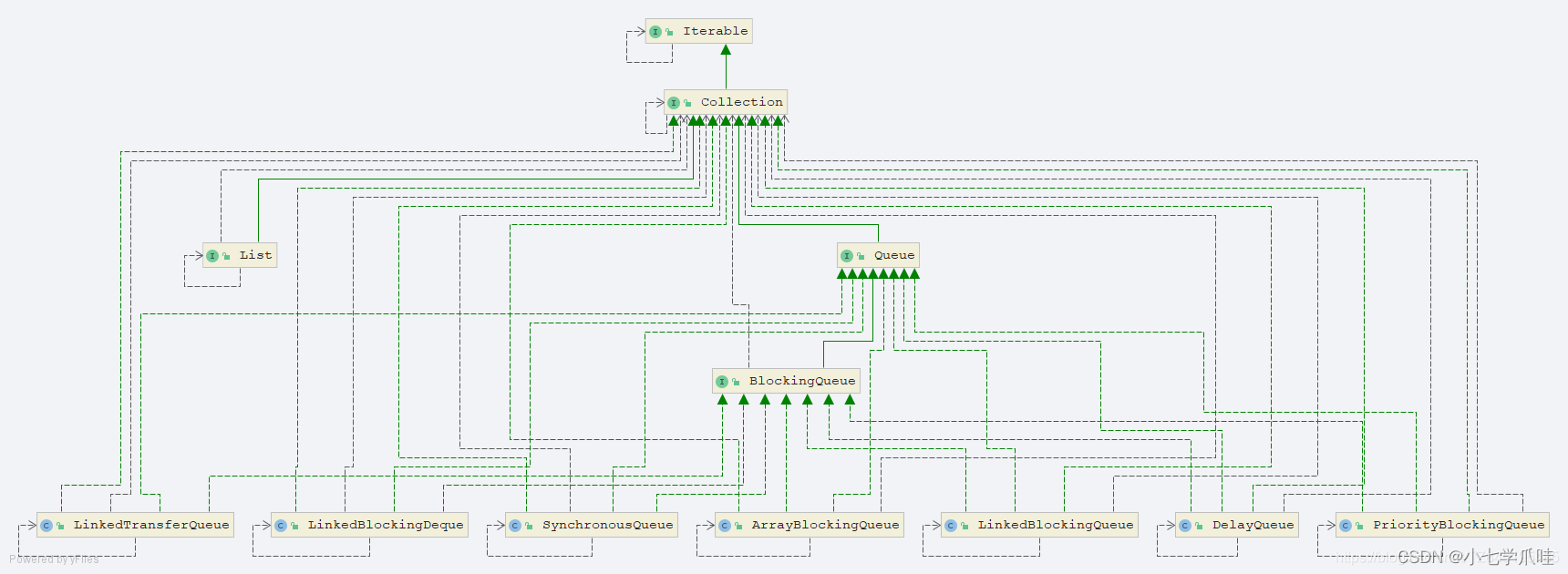1、 阻塞队列概述
- ①. 什么是阻塞队列?
阻塞队列:顾名思义,首先它是一个队列,而一个阻塞队列在数据结构中所起的作用大致如图所示,当阻塞队列是空时,从队列中获取元素的操作将会被阻塞
- ②. 为什么用?有什么好处?
- 好处是我们不需要关心什么时候需要阻塞线程,什么时候需要唤醒线程,因为BlockingQueue都一手给你包办好了
- 在concurrent包发布以前,在多线程环境下,我们每个程序员都必须自己去控制这些细节,尤其还要兼顾效率和线程安全,而这会给我们的程序带来不小的复杂度

2、阻塞队列种类
-
①.
ArrayBlockingQueue:由数组结构组成的有界阻塞队列 -
②.
LinkedBlockingQueue:由链表结构组成的有界(但大小默认值 Integer>MAX_VAL UE)阻塞队列 -
③.
SynchronousQueue:不存储元素的阻塞队列,也即是单个元素的队列
- SynchronousQueue没有容量,与其他BlcokingQueue不同,SynchronousQueue是一个不存储元素的BlcokingQueue
- 每个put操作必须要等待一个take操作,否则不能继续添加元素,反之亦然
-
④. PriorityBlockingQueue:支持优先级排序的无界阻塞队列
-
⑤. LinkedTransferQueue:由链表结构组成的无界阻塞队列
-
⑥. LinkedBlockingDeque:由了解结构组成的双向阻塞队列
public class SynchronousQueueDemo {
public static void main(String[] args) {
BlockingQueue<String> blockingQueue = new SynchronousQueue<>();
new Thread(() -> {
try {
System.out.println(Thread.currentThread().getName() + "\t put 1");
blockingQueue.put("1");
System.out.println(Thread.currentThread().getName() + "\t put 2");
blockingQueue.put("2");
System.out.println(Thread.currentThread().getName() + "\t put 3");
blockingQueue.put("3");
} catch (InterruptedException e) {
e.printStackTrace();
}
}, "AAA").start();
new Thread(() -> {
try {
try {
TimeUnit.SECONDS.sleep(5);
} catch (InterruptedException e) {
e.printStackTrace();
}
System.out.println(Thread.currentThread().getName() + "\t" + blockingQueue.take());
try {
TimeUnit.SECONDS.sleep(5);
} catch (InterruptedException e) {
e.printStackTrace();
}
System.out.println(Thread.currentThread().getName() + "\t" + blockingQueue.take());
try {
TimeUnit.SECONDS.sleep(5);
} catch (InterruptedException e) {
e.printStackTrace();
}
System.out.println(Thread.currentThread().getName() + "\t" + blockingQueue.take());
} catch (InterruptedException e) {
e.printStackTrace();
}
}, "BBB").start();
}
}3、 BlockingQueue的核心方法
- ①. 各种方法如下


public class BlockingQueueExceptionDemo { public static void main(String[] args) throws Exception { //List list=new ArrayList(); //注意:这里要给一个初始值 BlockingQueue<String> blockingQueue=new ArrayBlockingQueue<>(3); //add() 方法是给ArrayBlockingQueue添加元素,如果超过会抛出异常! System.out.println(blockingQueue.add("a"));//true System.out.println(blockingQueue.add("b"));//true System.out.println(blockingQueue.add("c"));//true //element是检查元素有没有? 检查的是出栈的元素 System.out.println(blockingQueue.element()); //remove() System.out.println(blockingQueue.remove());//a System.out.println(blockingQueue.remove());//b System.out.println(blockingQueue.remove());//c // offerAndPoll(); } public static void offerAndPoll() throws Exception { BlockingQueue blockingQueue=new ArrayBlockingQueue(3); //前三个直接成功 System.out.println(blockingQueue.offer("a", 2L, TimeUnit.SECONDS)); System.out.println(blockingQueue.offer("a", 2L, TimeUnit.SECONDS)); System.out.println(blockingQueue.offer("a", 2L, TimeUnit.SECONDS)); //下面这个会阻塞2s System.out.println(blockingQueue.offer("a", 2L, TimeUnit.SECONDS)); } }























 339
339

 被折叠的 条评论
为什么被折叠?
被折叠的 条评论
为什么被折叠?








